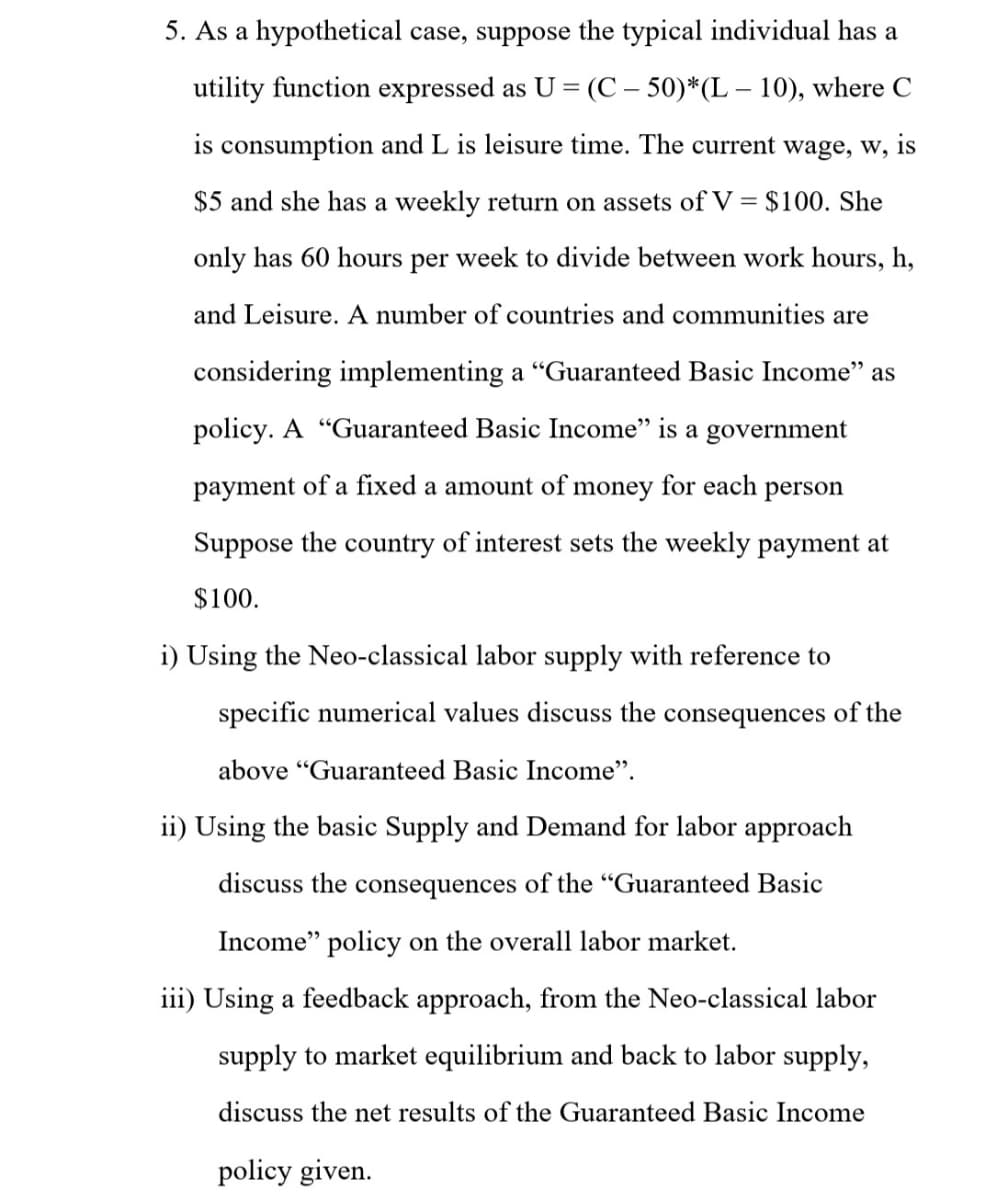5. As a hypothetical case, suppose the typical individual has a utility function expressed as U = (C – 50)*(L – 10), where C is consumption and L is leisure time. The current wage, w, is $5 and she has a weekly return on assets of V = $100. She only has 60 hours per week to divide between work hours, h, and Leisure. A number of countries and communities are considering implementing a “Guaranteed Basic Income" as policy. A "Guaranteed Basic Income" is a government payment of a fixed a amount of money for each person Suppose the country of interest sets the weekly payment at $100. i) Using the Neo-classical labor supply with reference to specific numerical values discuss the consequences of the above "Guaranteed Basic Income". ii) Using the basic Supply and Demand for labor approach discuss the consequences of the "Guaranteed Basic Income" policy on the overall labor market. iii) Using a feedback approach, from the Neo-classical labor supply to market equilibrium and back to labor supply, discuss the net results of the Guaranteed Basic Income policy given.
5. As a hypothetical case, suppose the typical individual has a utility function expressed as U = (C – 50)*(L – 10), where C is consumption and L is leisure time. The current wage, w, is $5 and she has a weekly return on assets of V = $100. She only has 60 hours per week to divide between work hours, h, and Leisure. A number of countries and communities are considering implementing a “Guaranteed Basic Income" as policy. A "Guaranteed Basic Income" is a government payment of a fixed a amount of money for each person Suppose the country of interest sets the weekly payment at $100. i) Using the Neo-classical labor supply with reference to specific numerical values discuss the consequences of the above "Guaranteed Basic Income". ii) Using the basic Supply and Demand for labor approach discuss the consequences of the "Guaranteed Basic Income" policy on the overall labor market. iii) Using a feedback approach, from the Neo-classical labor supply to market equilibrium and back to labor supply, discuss the net results of the Guaranteed Basic Income policy given.
Chapter17: Capital And Time
Section: Chapter Questions
Problem 17.2P
Related questions
Question

Transcribed Image Text:5. As a hypothetical case, suppose the typical individual has a
utility function expressed as U = (C – 50)*(L – 10), where C
is consumption and L is leisure time. The current wage, w, is
$5 and she has a weekly return on assets of V = $100. She
only has 60 hours per week to divide between work hours, h,
and Leisure. A number of countries and communities are
considering implementing a "Guaranteed Basic Income" as
policy. A "Guaranteed Basic Income" is a government
payment of a fixed a amount of money for each person
Suppose the country of interest sets the weekly payment at
$100.
i) Using the Neo-classical labor supply with reference to
specific numerical values discuss the consequences of the
above "Guaranteed Basic Income".
ii) Using the basic Supply and Demand for labor approach
discuss the consequences of the "Guaranteed Basic
Income" policy on the overall labor market.
iii) Using a feedback approach, from the Neo-classical labor
supply to market equilibrium and back to labor supply,
discuss the net results of the Guaranteed Basic Income
policy given.
Expert Solution
This question has been solved!
Explore an expertly crafted, step-by-step solution for a thorough understanding of key concepts.
Step by step
Solved in 5 steps with 4 images

Knowledge Booster
Learn more about
Need a deep-dive on the concept behind this application? Look no further. Learn more about this topic, economics and related others by exploring similar questions and additional content below.Recommended textbooks for you


Exploring Economics
Economics
ISBN:
9781544336329
Author:
Robert L. Sexton
Publisher:
SAGE Publications, Inc


Exploring Economics
Economics
ISBN:
9781544336329
Author:
Robert L. Sexton
Publisher:
SAGE Publications, Inc